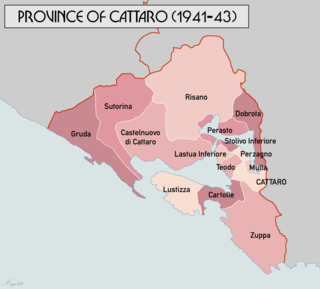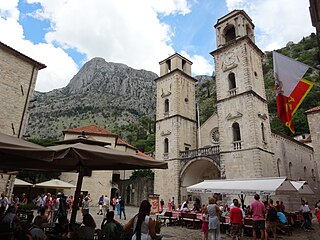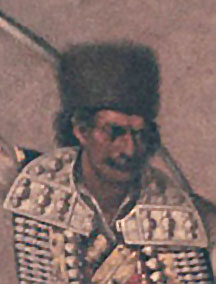
Kotor is a coastal town in Montenegro. It is located in a secluded part of the Bay of Kotor. The city has a population of 13,510 and is the administrative center of Kotor Municipality.

The Bay of Kotor, also known as the Boka, is a winding bay of the Adriatic Sea in southwestern Montenegro and the region of Montenegro concentrated around the bay. It is also the southernmost part of the historical region of Dalmatia. The bay has been inhabited since antiquity. Its well-preserved medieval towns of Kotor, Risan, Tivat, Perast, Prčanj and Herceg Novi, along with their natural surroundings, are major tourist attractions. The Natural and Culturo-Historical Region of Kotor was designated a UNESCO World Heritage Site in 1979. Its numerous Orthodox and Catholic churches and monasteries attract numerous religious pilgrims and other visitors.

Province of Cattaro was a province of the Italian Governorate of Dalmatia, created in May 1941 during World War II. It lasted until September 1943.

Perast is an old town in the Bay of Kotor in Montenegro. It is situated a few kilometres northwest of Kotor and is noted for its proximity to the islets of St. George and Our Lady of the Rocks.

Risan is a town in the Bay of Kotor, Montenegro. It traces its origins to the ancient settlement of Rhizon, the oldest settlement in the Bay of Kotor.
The Italian title prov[v]editore, "he who sees to things", was the style of various local district governors in the extensive, mainly maritime empire of the Republic of Venice. Like many political appointments, it was often held by noblemen as a stage in their career, usually for a few years.
The Montenegrin Littoral, historically known as the Littoral or the Maritime, is the littoral or coastline region of Montenegro which borders the Adriatic Sea. The littoral was lost to Austria and Turkey during its collapse due to Ottoman invasion - but it was regained in 1878 and 1918 following the Serbian-Montenegrin victories in the Russo-Turkish War and World War 1 respectively.

The Catholic Church in Montenegro is part of the worldwide Catholic Church, under the spiritual leadership of the Pope in Rome. There are 21,299 Catholics in Montenegro, and they form three and a half percent of the population. Most Catholics are ethnic Albanians, Montenegrins and Croats.
The architecture of Montenegro is a mixture of many influences, from Roman and Venetian to Ottoman and modern times.

Osanna of Cattaro was a Catholic visionary and anchoress from Cattaro. She was a teenage convert from Orthodoxy of Serbian descent from Montenegro. She became a Dominican tertiary and was posthumously venerated as a saint in Kotor. She was later beatified in 1934.

Venetian Albania was the official term for several possessions of the Republic of Venice in the southeastern Adriatic, encompassing coastal territories primarily in present-day southern Montenegro and partially in northern Albania.

Alvise III Sebastiano Mocenigo (1662–1732) was the 112th Doge of Venice from 1722 to 1732. He was also Provveditore Generale (Governor) of Venetian Dalmatia twice.

The fortifications of Kotor are an integrated historical fortification system that protected the medieval town of Kotor containing ramparts, towers, citadels, gates, bastions, forts, cisterns, a castle, and ancillary buildings and structures. They incorporate military architecture of Illyria, Byzantium, Venice, and Austria. Together with the old town and its natural surroundings the fortifications were inscribed in the list of World Heritage Sites in 1979 labelled Natural and Culturo-Historical Region of Kotor and represent the only such site of cultural significance in Montenegro.

Prčanj is a small town along the Bay of Kotor, Montenegro. According to the 2011 census, the town has a population of 1128 people.

Bajo Pivljanin, born Dragojlo Nikolić, was a Montenegrin and Serbian hajduk commander mostly active in the Ottoman territories of Herzegovina and southern Dalmatia. Born in Piva, at the time part of the Ottoman Empire, he was an oxen trader who allegedly left his village after experiencing Ottoman injustice. Mentioned in 1654 as a brigand during the Venetian–Ottoman war, he entered the service of the Republic of Venice in 1656. The hajduks were used to protect Venetian Dalmatia. He remained a low-rank hajduk for the following decade, participating in some notable operations such as the raid on Trebinje. Between 1665 and 1668 he quickly rose through the ranks to the level of harambaša. After the war, which ended unfavourably for the Venetians, the hajduks were moved out of their haven in the Bay of Kotor under Ottoman pressure. Between 1671 and 1684 Pivljanin, along with other hajduks and their families, were refugees in Dalmatia. Upon renewed conflict, he was returned to the Bay of Kotor and placed in charge of defending the frontier; in 1685 he and his band fell in battle against the advancing Ottoman governor of Scutari. Regarded as one of the most distinguished hajduks of his time, he is praised in Serbian epic poetry.

Zeta was one of the South Slavic medieval polities that existed between 1356 and 1496, whose territory encompassed parts of present-day Montenegro and northern Albania. The Crnojević noble family ruled the Zeta from 1451 until 1496. The state included parts of modern Montenegro and parts of modern Albania.

Trg od Oružja is the main and the largest town square in Kotor, Montenegro. It hosts several stores, banks, cafés, bakeries and pastry shops, as well as many important cultural-historical monuments. Its name hails from Venetian times, when munitions were made and stored here.
Marco Barbarigo was a Venetian nobleman, who married Helena Thopia and thus inherited the rule of Croia (Krujë), which he initially held under Venetian and later, after quarrelling with Venetian noblemen, Ottoman suzerainty, until in late 1394 when he was defeated by Venetian subject Niketa Thopia and forced into exile at the court of Đurađ II Balšić. He was appointed the Venetian governor of Cattaro (Kotor) in ca. 1422.
Derviš-beg Alić Sarvanović, known as Derviš Alić or Dervish Bey was the Ottoman governor of the sanjak of Montenegro from 1592 to at least 1597. He was from Peć.
Mazarek was an Albanian nobleman and general in the service of the Serbian Despotate, with the title of vojvoda. At the beginning of the 15th century he was the governor of Rudnik and Ostrvica in Serbia. He was one of the commanders of Serbian troops during the Second Scutari War (1419–23) between Serbia and Venice. After death of Balša III in 1421 Mazarek was appointed the governor of Zeta.













